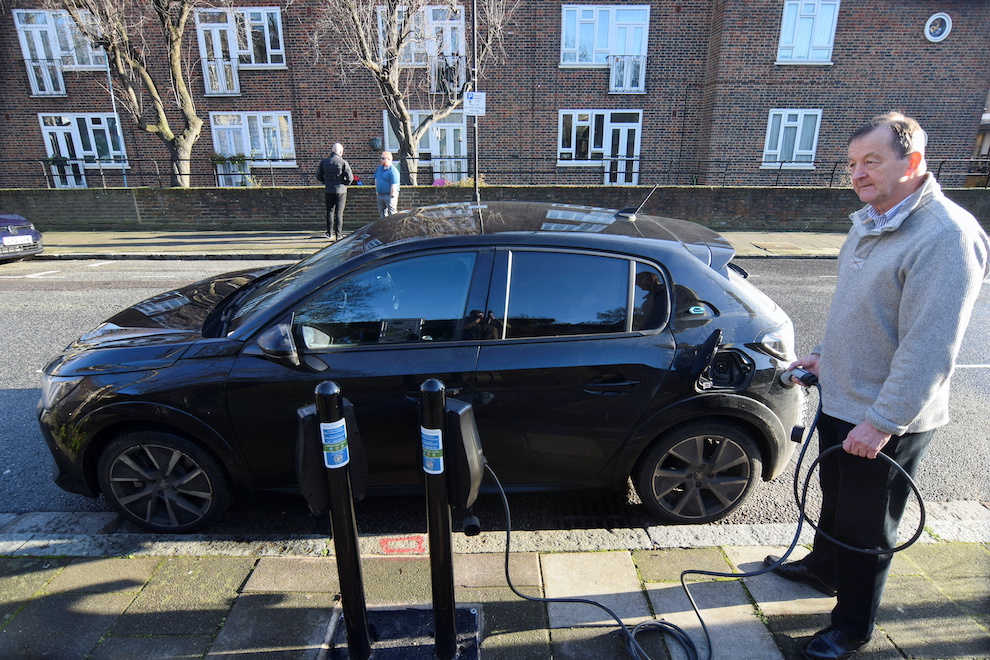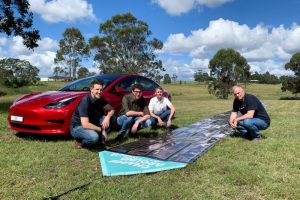As electric vehicle (EV) sales rise, the big question for power grid operators, charging companies and governments is how to run tens of millions of vehicles without crashing local networks or spending billions on grid upgrades.
The answer: smart charging.
Simply put, smart charging software allows EV owners to plug in during expensive peak hours, without the vehicle drawing power until cheap off-peak hours. This eases strain on the electric grid, makes better use of renewable energy and saves drivers money.
Without it, millions of EV owners plugging in after work – auditing firm EY estimates that Europe will have 65 million electric vehicles by 2030 and 130 million by 2035 – could overload local grids, causing blackouts.
“The shift to electric will be nigh on impossible without smart charging,” Chris Pateman-Jones, CEO of British EV charger company Connected Kerb, said while demonstrating a pilot project on public chargers in Hackney, a London borough.
Using Connected Kerb’s smartphone app you can set your charging speed, charge time and exact price down to a low, slow “Eco” rate of 19 pence (26 US cents) per kilowatt.
“It’s so much cheaper and simpler,” said Ged O’Sullivan, a 65-year-old pub owner who cut his plug-in hybrid’s charging bill by 30% with Connected Kerb.
Smart charging for public chargers is a significant challenge because so few are available for people who cannot charge at home because they park on the street.
According to a report from EY and Eurelectric, Europe alone will need 9 million public chargers by 2035, up from 374,000 today.
Bi-directional Charging?
The near future should also bring “bi-directional” or “vehicle-to-grid” charging, where millions of EV owners could sell their EV batteries’ juice back to grid operators during peak hours.
Even in Britain where smart charging at home is widely available, many EV owners are unaware it exists, according to Britain’s energy regulator, Ofgem. In the United States, only a tiny fraction of utilities offer it, according to utilities group the Smart Electric Power Alliance.
And few cars today beside Renault and Hyundai’s upcoming Ioniq model are capable of bi-directional charging – though more are coming.
“Most cars, at this point, do not support this bi-directional charging yet,” said Robin Berg, CEO of We Drive Solar, which has supplied hundreds of bi-directional chargers for a pilot project in the central Dutch city of Utrecht and worked with Renault SA and Hyundai Motor Co on their vehicles. “Other carmakers will follow.”
Nearly 20% of new cars sold in the Netherlands and almost 12% in Britain in 2021 were fully electric.
State support has put Norway at the forefront of electrification, where EVs made up almost three-quarters of sales in the capital Oslo. Some local substations were built in the 1950s and without smart charging Oslo would need massive, costly grid upgrades.
“To handle this we need smart charging solutions because we don’t want to over-invest in the grid,” said Sture Portvik, who heads Oslo’s charging infrastructure efforts.
‘Awareness is Low’
Connected Kerb aims to have 190,000 UK on-street chargers by 2030, enabling it to predict consumer charging patterns for grid operators and offer lower rates when the available renewable energy is abundant, said Pateman-Jones.
“Today when there’s too much wind on the grid, wind farms are told to turn the wind turbines off,” he said. “With smart charging we can pull more of that power.”
Some UK energy providers already offer low off-peak rates for home smart charging, but few EV owners use them.
“The perception is smart charging at home is a done deal,” said Charlie Cook, CEO of Rightcharge, a UK firm that helps EV owners find low tariffs. “But the reality is awareness of these tariffs is surprisingly low.”
Rightcharge estimates smart charging could save UK drivers 10 billion pounds ($13.5 billion) by 2030.
British car dealer network Lookers guides EV buyers to Rightcharge’s website to check their options.
Lookers’ business development director, Andrew Hall, said “early adopter” EV buyers are “pretty savvy about smart charging.”
“But that is changing as EV sales rise,” he added.
Utilities group the Smart Electric Power Alliance estimates only 50 out of 3,000 US utilities offer smart charging.
EV charging company ChargePoint‘s US chargers can all smart-charge, but it wants more utilities to offer it.
“We see a lot of positive response from customers when their utility is offering those rates,” said Anthony Harrison, ChargePoint’s North American head of utility partnerships.
Charging provider Blink Charging Co has one set rate until smart charging is widely available.
“We decided to keep it simple for our customers,” said Blink CEO Michael Farkas.
‘Horrendously Expensive Grid Upgrades’
Bi-directional charging may be crucial.
“The whole idea behind bi-directional charging is to balance the grid,” said We Drive Solar’s Berg, who estimates a fully charged EV can power the average home in the Netherlands for a week.
Serge Colle, EY’s global energy resources leader, said smart and bidirectional charging are better than “horrendously expensive” power grid upgrades.
“We can’t possibly open up streets quickly enough to add more copper and do the necessary reinforcement,” Colle said.
Regulator Ofgem estimates that peak power reductions from smart and bi-directional charging by 2050 could match “10 Hinkley Point C Nuclear Plants” – a two-reactor plant under construction in England.
The US market has more than 10 vehicle-to-grid pilot projects using school buses under way.
California-based vehicle-to-grid company Nuvve Holding Corp has formed Levo, a joint venture with private equity firm Stonepeak – which chipped in $750 million – to enable EV fleet owners to sell power to utilities.
“Because our customers are able to generate revenue we’re able to reduce the total cost of ownership for those vehicles, at times completely cost-neutral,” said Nuvve CEO Gregory Poilasne.
Charger makers like Brisbane, Australia-based Tritium Dcfc Ltd are also developing bi-directional chargers.
CEO Jane Hunter said Tritium will launch a bi-directional, fast-charging wall unit in 2023 for fleets and homeowners.
More automakers are embracing bi-directional charging. Ford Motor Co has partnered with solar power company Sunrun Inc to use its F-150 Lightning pickup truck to power homes.
But Oslo has invested extra money in pilot projects for bi-directional chargers because it believes in the concept. So far, however, it has been disappointed that more carmakers have not yet introduced vehicles that can feed power back into the grid.
“The limitations for bi-directional charging has been the car producers,” infrastructure chief Portvik said. “The big carmakers have to step up.”
- Reuters with additional editing by Jim Pollard
ALSO on AF:
China’s CATL Launches Fast Battery Swap Service for Electric Cars
LG Energy Solution IPO In Korea Seen Drawing $80bn In Bids
Battery Giants Face Skills Gap That Could Jam EV Transition
Tesla-Supplier CATL Unveils Groundbreaking Sodium-Ion Battery
Chinese Companies Ramp Up Investment in Lithium Batteries




















